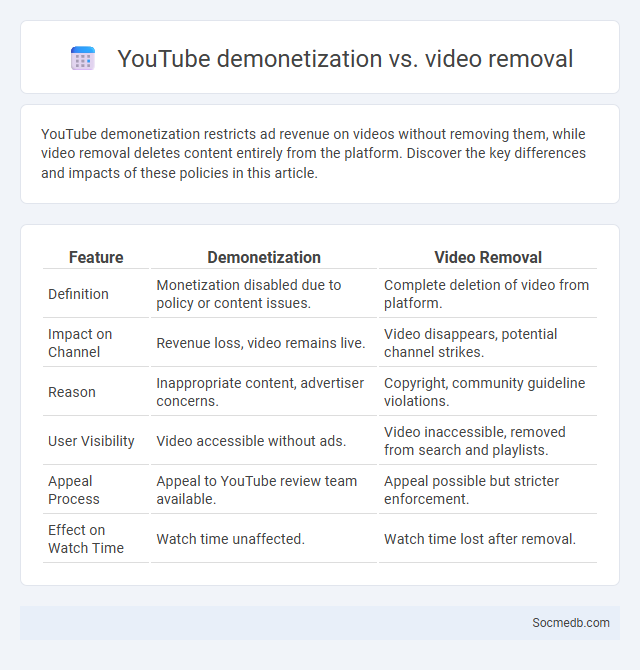
Photo illustration: YouTube demonetization vs video removal
YouTube demonetization restricts ad revenue on videos without removing them, while video removal deletes content entirely from the platform. Discover the key differences and impacts of these policies in this article.
Table of Comparison
| Feature | Demonetization | Video Removal |
|---|---|---|
| Definition | Monetization disabled due to policy or content issues. | Complete deletion of video from platform. |
| Impact on Channel | Revenue loss, video remains live. | Video disappears, potential channel strikes. |
| Reason | Inappropriate content, advertiser concerns. | Copyright, community guideline violations. |
| User Visibility | Video accessible without ads. | Video inaccessible, removed from search and playlists. |
| Appeal Process | Appeal to YouTube review team available. | Appeal possible but stricter enforcement. |
| Effect on Watch Time | Watch time unaffected. | Watch time lost after removal. |
Understanding YouTube’s Content Policies
YouTube's content policies are designed to promote a safe and positive environment by prohibiting harmful or inappropriate content such as hate speech, misinformation, and copyright violations. Understanding these guidelines helps creators avoid strikes and demonetization, ensuring your videos remain accessible and monetizable. Staying updated with YouTube's policy changes maximizes your channel's growth potential and community trust.
What Is YouTube Demonetization?
YouTube demonetization refers to the process where videos are flagged and removed from monetization due to violations of YouTube's advertiser-friendly content guidelines, impacting creators' revenue. This occurs when content is deemed unsuitable for ads, including topics like violence, controversial issues, or inappropriate language. Understanding YouTube's policies and community guidelines is essential for content creators to avoid demonetization and maintain consistent earnings.
Common Reasons for Video Demonetization
You can face video demonetization on social media platforms due to content violations such as inappropriate language, graphic violence, or copyright infringement. Videos containing misleading information, hate speech, or failure to comply with platform guidelines also risk losing monetization privileges. Ensuring your content adheres to community standards and copyright rules is crucial for maintaining revenue streams.
YouTube Video Removal: Causes and Consequences
YouTube video removal can occur due to copyright infringement, community guideline violations, or spam and misleading content, disrupting your channel's reach and subscriber engagement. YouTube enforces strict policies to maintain a safe environment, and repeated violations can lead to strikes or channel termination. Understanding these causes helps you protect your content and maintain your channel's reputation and growth potential.
Key Differences: Demonetization vs Video Removal
Demonetization on social media restricts your ability to earn revenue from videos without removing the content entirely, often due to policy violations like inappropriate content or copyright issues. Video removal permanently deletes the content from the platform, usually for severe breaches such as hate speech, violent content, or repeated offenses. Understanding these distinctions helps you manage content compliance while maintaining your channel's monetization potential.
Impact of Demonetization on Channel Revenue
Social media channels experienced significant revenue fluctuations following demonetization policies implemented by platforms like YouTube. Many content creators faced reduced ad revenue due to stricter monetization criteria and content guidelines aimed at improving advertiser safety. This shift led to increased diversification of income streams, such as sponsorships and crowdfunding, as creators sought to offset diminishing ad-based earnings.
How Video Removal Affects Channel Reputation
Video removal can significantly impact your channel reputation by reducing content availability and disrupting viewer engagement metrics such as watch time and subscriber growth. When videos are removed, it may signal to algorithms and your audience a lack of reliability or potential policy violations, affecting trust and reach. Maintaining a consistent content library with clear compliance helps preserve your channel's credibility and long-term visibility on social media platforms.
YouTube’s Appeal Process: Recovering Monetization
YouTube's appeal process for recovering monetization allows creators to contest demonetization decisions by submitting a detailed review request through the YouTube Studio interface. Maintaining compliance with YouTube's monetization policies, including adhering to community guidelines and avoiding copyright violations, increases the likelihood of a successful appeal. Timely and accurate appeals can restore monetization features such as ad revenue, channel memberships, and Super Chat, ensuring creators regain their income streams swiftly.
Preventing Demonetization and Video Removal
To prevent demonetization and video removal on social media platforms, creators must strictly adhere to community guidelines and copyright policies, ensuring all content is original or properly licensed. Utilizing accurate metadata, appropriate tags, and clear content descriptions helps platforms correctly categorize videos and avoid false claims. Regularly reviewing platform updates and engaging with creator support channels also minimizes risks and maintains video monetization status.
Best Practices for Compliant YouTube Content
Creating compliant YouTube content requires adherence to community guidelines, copyright laws, and advertiser-friendly standards to avoid strikes and demonetization. You should focus on using original or properly licensed media, provide clear disclosures for sponsored content, and avoid prohibited topics like hate speech or misinformation. Regularly reviewing YouTube's policies ensures your videos remain compliant and maintain audience trust.
 socmedb.com
socmedb.com